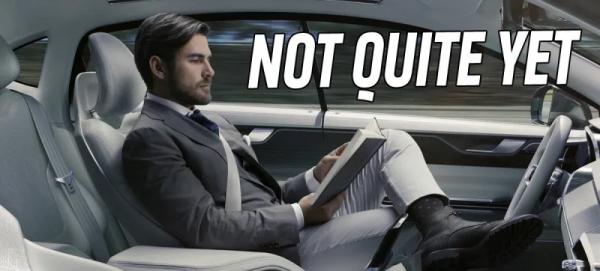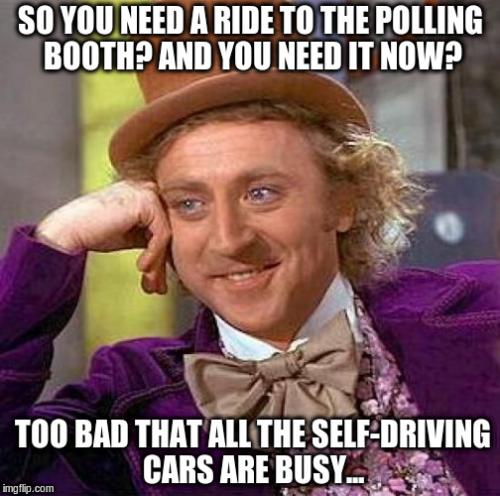Autonomous, driverless cars need 5G? Wait a minute...
Time for (another) reality check here.

<u><em><strong>CAPTION:</strong>
<a href="https://jalopnik.com/dont-believe-the-hype-about-a-driverless-society-being-1790269631" target="_blank">Click for image source</a>
</em></u>
I only noticed now that last January, an autonomous vehicle expert gave this explanation of why “5G will make autonomous vehicles safer”:
“Right now, anything over a hundred milliseconds of latency (definable like the delay between detecting something, and reacting to it) is going to cause our car to disrupt… that’s where 5G comes in… 5G promises one-millisecond latency… Now we’ve solved the latency problem associated with getting commands, and video, back and forth between the car and the command station.”
Following that lead, I found another expert saying basically the same thing in March 2018: “Autonomous Cars Won’t Work - Until We Have 5G” or, more exactly, “until 5G data networks are ubiquitous”.
Why? Because 4G, the current version of high-speed wireless data networks], “offers enough bandwidth and speed to allow real-time information and location sharing. [This is] still not fast enough to support technologies that require the speed of human reflexes [that might prevent accidents]. That’s where 5G comes in.”
The reason, according to the article, is that (emphasis mine) “when it comes to autonomous vehicles, the speeds and data processing capabilities needed to mimic the timing of human reflexes are incredible.”
That second article also include estimates that these cars will “generate approximately the equivalent of two-million gigabits”, meaning that “with an advanced Wi-Fi connection, it will take 230 days to transfer a weeks-worth of data from a self-driving car”.
Huh???

Please excuse me for having bad feelings, and four questions, about all this.
The speed of ** HUMAN ** reflexes? HUMAN?
So, society should jump head first into an additional source of massive pollution, finance huge investments, endure huge industry restructuring (which will NOT create enough new jobs accessible to the many people it will make redundant. Just forget about that), etc.. all this to get…
what we already have, that is machines with the same lousy reflexes (i.e. low safety) as us mere humans? Huh??? Gee, now that is an impressive business case. I really hope they at least meant something else.
“Until We Have 5G”?
Hold your horses then, rather than your driverless cars: “Forget all those stories of 20 Gbps speeds and 1 millisecond latency. 5G will never deliver performance like that”.
“Autonomous” Vehicles?
No NewsSpeak, please: what the articles above are about are “driverless”, not “autonomous” vehicles. Anything that is told how to move and where to (not) go from a remote “command station” is not autonomous. Above all, very likely isn’t even going to be really yours, to always carry you wherever you please, whenever you need it:

<u><em><strong>CAPTION:</strong>
<a href="/2017/10/the-real-name-and-value-of-self-driving-cars/" target="_blank">For more on this, click here</a>
</em></u>
Speaking of which.. A weeks-worth of data about WHAT?
Remember: what we are talking about here is cars: boxed seats with wheels, for daily, routine transportation of big masses of ordinary people". Not the Large Hadron Collider.
Just how much bandwidth is needed, and why? According to some references I have found, 5G is essential to make driverless cars transmit:
- Twenty-five gigabytes PER HOUR of “data about everything: route, speed, wear and tear on its components, road conditions…”
- No, wait, that’s too little: 4K Gigabytes per one hour of driving!.
How? Quoting from that last piece:
- “hundreds of on-vehicle sensors”
- “Cameras alone will generate 20 to 40 Mbps, and the radar will generate between 10 and 100 Kbps”
- Personal data [including] “locations and stop time…”
- Maps that “will have to be extremely detailed and timely - down to the nearest inch. They will be used for lane control and road hazards, among other things, so they will need to be continuously updated.”
- “crowd-sourced data, for example to automatically generate crowd-sourced traffic reports”, but also
- provide vital feedback for cities and states about traffic volume and roadway design
Let’s look at those “needs” one at a time:
Number 1: If what those “hundreds of sensors” measures is the status of the car then, with the possible exception of brakes, light failures and heart stroke of some passenger, that is all stuff that has no need at all to be transmitted real-time. Your maintenance technician can wait one day to know you should be scheduled for an oil change. Get real.
Number 2 and 3: Here, it doesn’t even matter whether all those data must or not (see above) be transferred in real time. Very likely, most of them should not exist in the first place. I can’t believe I’ve read such a ridiculous privacy and surveillance nightmare. And I cannot wait until GDPR or some cyber attack will make that “need” crumble below 4K Gigabytes per hour of lawsuits.
Number 4 and 5: anything that needs to continuously send to, or receive from a remote “command station” that much data in real time, just to be safe is not safe, period. Thanks, but no thanks. What a car needs anyway, no matter what, is its own, totally LOCAL and independent system, be it a human or a computer, that makes it brake if there is an obstacle in its way. Even if the “command station” is unreachable. Transmitting that information to other cars that are not in the immediate surroundings is an extremely useful service, but not one that needs 5G. See Waze and Google Maps today.
Number 6: If you receive ten independent reports of a new pothole and its position “down to the nearest inch”, you know for sure where to send a road maintenance crew. Ditto for traffic flows patterns. Having such information is great for a city council. But the idea that such a council needs it in real time is ridiculous. It would need it only if it could and should take planning decision in real time. Or if any real-world council had, the possibility to fix potholes in real time. Get real. Think of real world cost-benefits ratios, not real-time transmission of data that can certainly wait hours (at least) to arrive. The only stuff that needs real-time transmission is emergency calls.
Summing up
If you buy the specific, bulimic, totally unrealistic vision of driverless cars outlined in those articles… then yes, you also need a network that is just as bulimic and unrealistic. That is 5G for you. Before going that route (and betting your money on it), however, I strongly suggest to (re)start from reality:
Who writes this, why, and how to help
I am Marco Fioretti, tech writer and aspiring polymath doing human-digital research and popularization.
I do it because YOUR civil rights and the quality of YOUR life depend every year more on how software is used AROUND you.
To this end, I have already shared more than a million words on this blog, without any paywall or user tracking, and am sharing the next million through a newsletter, also without any paywall.
The more direct support I get, the more I can continue to inform for free parents, teachers, decision makers, and everybody else who should know more stuff like this. You can support me with paid subscriptions to my newsletter, donations via PayPal (mfioretti@nexaima.net) or LiberaPay, or in any of the other ways listed here.THANKS for your support!